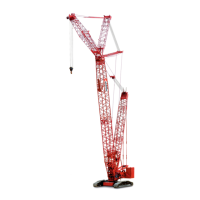National Crane PUBLISHED 04-26-2019 CONTROL # 113-09 2-25
600E2 OPERATOR MANUAL SAFETY PRECAUTIONS
• ASME (formerly ANSI) B30 Series American National
Safety Standards For Cableways, Cranes, Derricks,
Hoists, Hooks, Jacks, and Slings; ASME B30.5, Mobile
And Locomotive Cranes, and ASME B30.23, Personnel
Lifting Systems, are available by mail from the ASME, 22
Law Drive, Fairfield, New Jersey, 0700-2900
- or -
online at: www.asme.org/kb/standards
• US DOL/OSHA Rules and Regulations are available by
mail from the Superintendent of Documents, PO Box
371954, Pittsburgh, PA, 15250-7954.
ENVIRONMENTAL PROTECTION
Dispose of waste properly! Improperly disposing of waste
can threaten the environment.
Potentially harmful waste used in National cranes includes
— but is not limited to — oil, fuel, grease, coolant, air
conditioning refrigerant, filters, batteries, and cloths which
have come into contact with these environmentally harmful
substances.
Handle and dispose of waste according to local, state, and
federal environmental regulations.
When filling and draining equipment components, observe
the following:
• Do not pour waste fluids onto the ground, down any
drain, or into any source of water.
• Always drain waste fluids into leak proof containers that
are clearly marked with what they contain.
• Always fill or add fluids with a funnel or a filling pump.
• Immediately clean up any spills.
MAINTENANCE
The equipment must be inspected prior to use on each work
shift. The owner, user, and operator must ensure that routine
maintenance and lubrication are being dutifully performed.
Never operate a damaged or poorly maintained equipment.
National Crane continues to recommend that equipment be
properly maintained, regularly inspected and repaired as
necessary. National Crane reminds equipment owners to
ensure that all safety decals are in place and legible.
National Crane continues to urge equipment owners to
upgrade their equipment with rated capacity limiter and
control lever lockout systems for all lifting operations.
Shut down the equipment while making repairs or
adjustments.
Always perform a function check after repairs have been
made to ensure proper operation. Load tests should be
performed when structural or lifting members are involved.
Follow all applicable safety precautions in this manual when
performing equipment maintenance as well as equipment
operations.
Keep the equipment free of mud, dirt, and grease at all times.
Dirty equipment introduces hazards, wears-out faster, and
makes proper maintenance difficult. Cleaning solutions used
should be non-flammable, non-toxic and appropriate for the
job.
Routine maintenance and inspection of this equipment must
be performed by a qualified person(s) according to the
recommendations in the Manitowoc Crane Care
Maintenance and Inspection Manual. Any questions
regarding procedures and specifications should be directed
to your National Crane distributor.
Service and Repairs
Service and repairs to the equipment must only be
performed by a qualified person. All service and repairs must
be performed in accordance with manufacturer’s
recommendations, this manual, and the service manual for
this machine. If there is any question regarding maintenance
procedures or specifications, contact your National Crane
distributor for assistance.
Qualified person is defined as one who by reason of
knowledge, training and experience is thoroughly familiar
with the equipment’s operation and required maintenance as
well as the hazards involved in performing these tasks.
Training and qualification of maintenance and repair
personnel are equipment owner’s responsibility.
Any modification, alteration, or change to equipment which
affects its original design and is not authorized and approved
by National Crane is strictly prohibited. All replacement
parts must be National Crane approved. Such action
invalidates all warranties and makes the owner/user liable
for any resultant accidents.
Hydraulic Fluid:
• Do not use your hand or any part of your body to check
for hydraulic fluid leaks when the engine is running or
the hydraulic system is under pressure. Fluid in the
hydraulic system can be under enough pressure that it
will penetrate the skin, causing serious injury or death.
Use a piece of cardboard, or piece of paper, to search
WARNING
Fall Hazard!
Working at elevated heights without using proper fall
protection can result in severe injury or death.
Always use proper fall protection as required by local,
state or federal regulations.
Fo
r
Reference
Only

